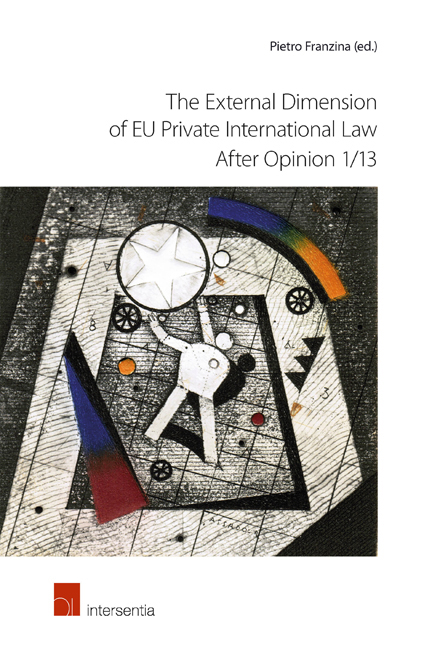Book contents
- Frontmatter
- Preface
- Contents
- PART I THE INTERNATIONAL PROJECTION OF EU PRIVATE INTERNATIONAL LAW - SOME BASIC ISSUES
- PART II OPINION 1/13 AND ITS IMPLICATIONS
- PART III THE CHANGING FEATURES OF EU EXTERNAL RELATIONS IN THE AREA OF PRIVATE INTERNATIONAL LAW
- EU External Relations and Private International Law: Multilateralism, Plurilateralism, Bilateralism, or Unilateralism?
- EU Cooperation in Civil Matters and Multilevel Unification of Private International Law: Some Remarks
- The Lugano Model - Cooperative Enhancement Over Enhanced Cooperation
- Regulations (EC) Nos 662/2009 and 664/2009: Can Exclusivity Be Successfully Reconciled with Flexibility?
- PART IV EU LEGISLATION ON PRIVATE INTERNATIONAL LAW AND EXTRA-EUROPEAN SITUATIONS
The Lugano Model - Cooperative Enhancement Over Enhanced Cooperation
from PART III - THE CHANGING FEATURES OF EU EXTERNAL RELATIONS IN THE AREA OF PRIVATE INTERNATIONAL LAW
Published online by Cambridge University Press: 15 December 2017
- Frontmatter
- Preface
- Contents
- PART I THE INTERNATIONAL PROJECTION OF EU PRIVATE INTERNATIONAL LAW - SOME BASIC ISSUES
- PART II OPINION 1/13 AND ITS IMPLICATIONS
- PART III THE CHANGING FEATURES OF EU EXTERNAL RELATIONS IN THE AREA OF PRIVATE INTERNATIONAL LAW
- EU External Relations and Private International Law: Multilateralism, Plurilateralism, Bilateralism, or Unilateralism?
- EU Cooperation in Civil Matters and Multilevel Unification of Private International Law: Some Remarks
- The Lugano Model - Cooperative Enhancement Over Enhanced Cooperation
- Regulations (EC) Nos 662/2009 and 664/2009: Can Exclusivity Be Successfully Reconciled with Flexibility?
- PART IV EU LEGISLATION ON PRIVATE INTERNATIONAL LAW AND EXTRA-EUROPEAN SITUATIONS
Summary
INTRODUCTION
In September 2010, during the legislative process leading to the recast of Regulation (EC) No 44/2001 on jurisdiction and the recognition and enforcement of judgments in civil and commercial matters (Brussels I), the European Parliament was faced with a proposal by the Commission, which suggested far-reaching inclusions of non-Member States bordering to a loi uniforme. The European Parliament responded that,
in view of the existence of large numbers of bilateral agreements between Member States and third countries, questions of reciprocity and international comity, the problem is a global one and a solution should also be sought in parallel in the Hague Conference through the resumption of negotiations on an international judgments convention’,
and accordingly mandated the Commission
to use its best endeavours to revive this project, the Holy Grail of private international law’ and urged the Commission to explore the extent to which the 2007 Lugano Convention could serve as a model and inspiration for such an international judgments convention.
This resolution, to which the Committee of Legal affairs adhered, sheds some light on the modern internal European perspective on the Lugano Convention: Lugano is the inter-governmental version of the Brussels I Regulation. Where Brussels I can thrive upon the primacy of the European ‘new legal order’ and hence follow the maxim lex iubeat, non disputet, Lugano must seek refuge in permanent consultation between the Convention States as laid out in its Protocol 2. While for the purpose of European integration, Lugano has delivered, harmonised regulation already having been reached, it is allegedly that very weakness which might be turned into a strength when looked at from an international political perspective. In the following, this apparent claim shall be assessed in four steps. First, some background on Lugano, its content and its historical development will be given. We will arrive at the conclusion that originally Lugano was planned as a soft vehicle for European integration. Second, the article will then sketch out a taxonomy of European integrative techniques spanning from simple bilateral treaties to quasi-federal, full integration in the European Union. It will be shown that in this spectrum Lugano is most aptly described as a multilateral treaty with a qualified institutional connection to the European Union and notably the ECJ.
- Type
- Chapter
- Information
- Publisher: IntersentiaPrint publication year: 2016

